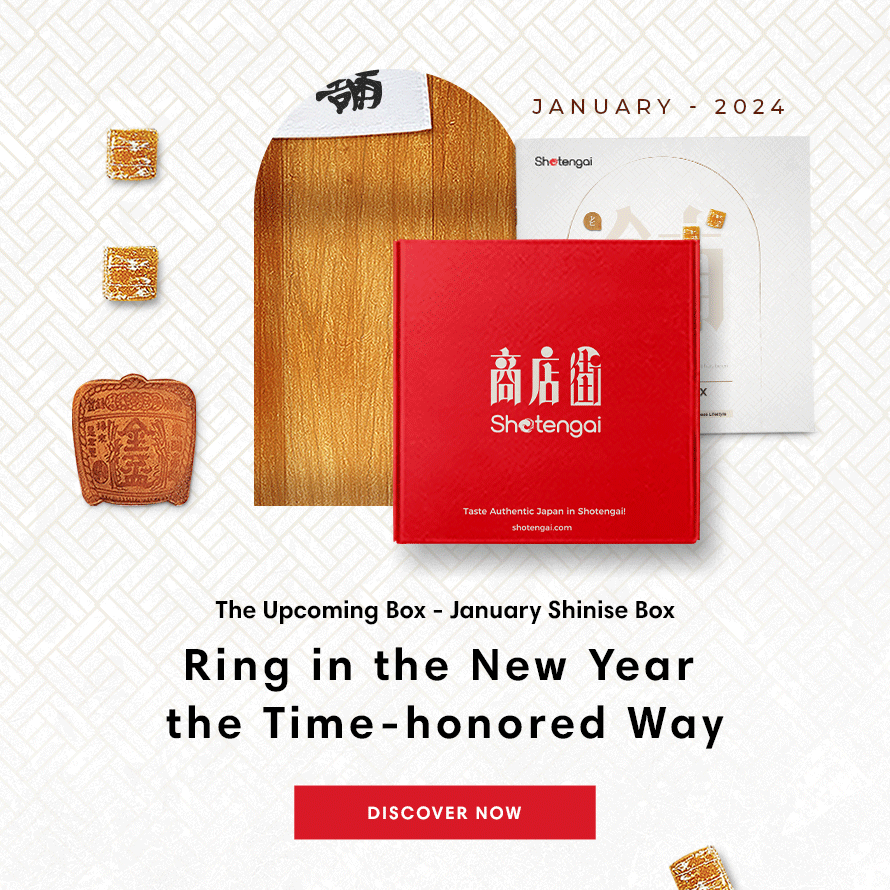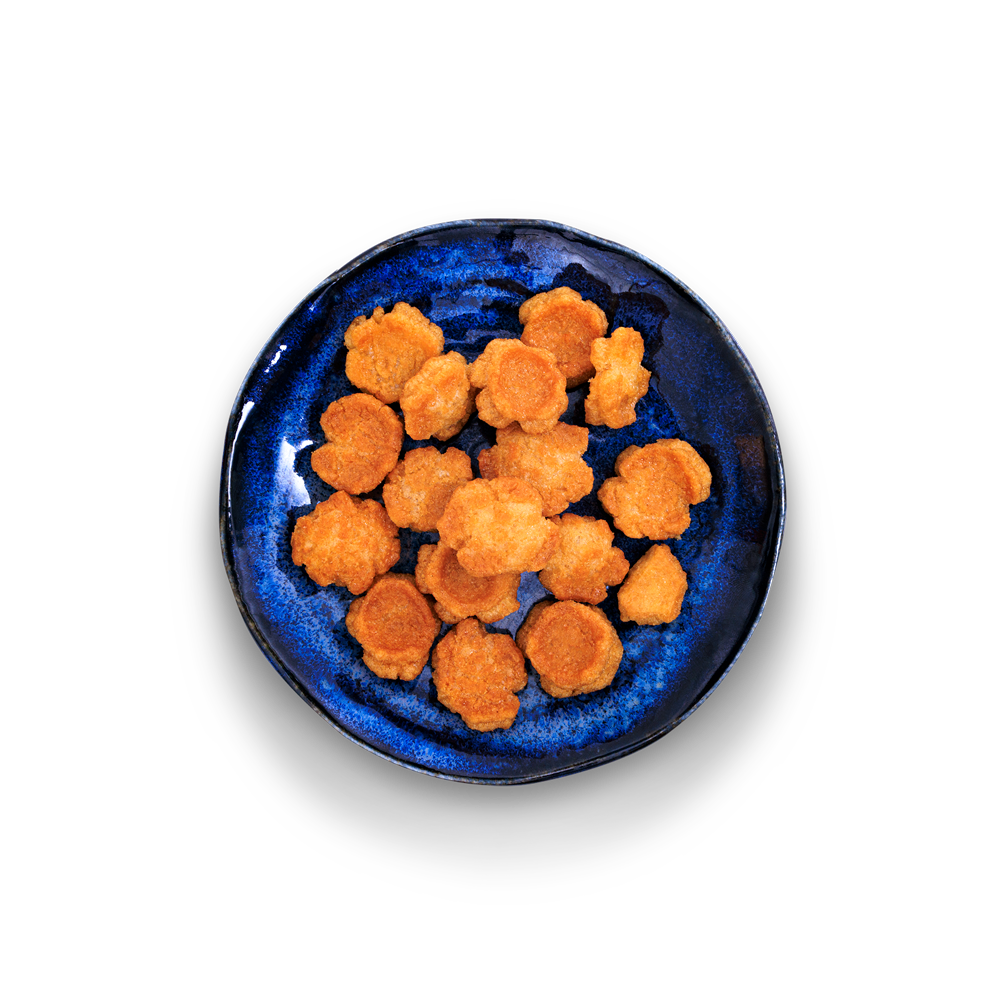

Ring in the New Year the Time-honored Way
The treats we have curated, produced by specialty shops some traceable back centuries, reflect the meaning behind Shinise - enduring and beloved. With packaging that invokes Japanese heritage and craftsmanship, this gift-worthy assortment lets snackers embark on a historic tasting journey to mark the nostalgic New Year festivities. Our Shinise snack box allows for both young and old to continue time-honored culinary customs passed down through generations.

技術と伝統の味
Passing the Torch to the Future
As the proprietor of the two-centuries-old Japanese confectionery Toraya Yoshisue, Yuusuke Manta feels immense pride in carrying on his family legacy spanning eight generations. Their shop still stands in the sake-brewing district of Nada where his ancestors first established it.
Having rebuilt after the devastating 1995 earthquake, Yusuke combines time-honored skills like pounding mochi rice and precision Wagashi shaping while integrating select contemporary techniques. He sources pristine water from the same local Mikage springs believed to have been consecrated by the legendary Empress Jingū. This refreshing liquid accentuates the flavors of Toraya Yoshisue’s abiding bestsellers like the barrel-shaped senbei rice crackers imprinted with sake brewery crests.
By respecting tradition while allowing for adaptation, Yusuke ensures enduring delight for loyal customers, just as his forefathers did. He aims to pass on these centuries-old recipes to the next generation with his innovative transformative touch.
Learn More In The Booklet Below👇
Every Taste and Story, All in One Box
Open the box and discover what you'll find!
A selection of quality products and the stories of where they came from, carefully chosen and curated for you!

By Tokunaga Seika (Since 1872)
Yasai à la carte
Tokunaga Seika is a confectionery manufacturer with a history spanning over 140 years. These vegetable chips are characterized by their vibrant colors and a crispy texture. They allow you to enjoy vegetables in a snack-like way, making it easy to incorporate them into your diet.
________
Common allergens: N/A
Also contains: N/A
Vegan

By Arima Hokodo (Since 1912)
Saku-Saku Kinako Soybeans
Arima Hokodo was founded in Kobe in 1912. The founder, Arima Yoshika, was involved in the import control of beans at Kobe's customs office, which led him to start making bean confections at his own shop. For over 110 years, the company has been exclusively selling bean confections and nuts.
Their "Saku-Saku Kinako Soybeans" features Japanese-grown soybeans coated in sweet kinako powder, delivering a crisp texture as suggested by its name, "saku-saku".
________
Common allergens: soy, wheat
Also contains: N/A
Vegan

By Yamato Seika
Kame-Sen
Despite its rugged appearance, Kame Senbei is a sweet and light-tasting rice cracker. "Kame" means "turtle" in Japanese. It earned this name because it resembles the shell of a turtle. Turtles are considered a symbol of longevity in Japan and are considered an auspicious animal. Kame Senbei is a classic snack enjoyed in Kumamoto Prefecture.
__________
Common allergens: wheat, soy
Also contains: honey
Vegetarian

By Arima Hokodo (Since 1912)
Non-fried High-Quality Nuts
Arima Hokodo was founded in Kobe in 1912. The founder, Arima Yoshika, was involved in the import control of beans at Kobe's customs office, which led him to start making bean confections at his own shop. For over 110 years, the company has been exclusively selling bean confections and nuts.
The "High-Quality Nuts" are not deep-fried in oil but are lightly dusted with the renowned Akashi salt, known for its high quality.
________
Common allergens: nuts
Also contains: walnuts, almonds, cashew nuts
Vegan

By Aoki-Koetsudo (Since 1892)
Ringo Yokan
Yokan is a wagashi (Japanese confection) made of red bean paste, agar, and sugar. It is often enjoyed alongside tea. While yokan typically comes in flavors like red-bean or chestnut, apple-flavored yokan is quite rare. The moment you open it, you can immediately smell its fruitiness.
__________
Common allergens: N/A
Also contains: apples

By Hayashi-Kyuemon Shoten (Since 1885)
Kinfuri-Katsuo Furikak
This is furikake made using dried bonito flakes. It can be sprinkled on not only rice but also salads, pasta, pizza, and more. Just a small amount can instantly give your dish a Japanese twist. Hayashi-Kyuemon Shoten has been handcrafting bonito flake products for over 130 years.
________
Common allergens: wheat, soy, sesame
Also contains: N/A
Vegetarian

By Hayakawa Shoyu Miso Co., Ltd. (Since 1885)
Instant Miso Powder
You can have instant miso soup made with only simple, additive-free ingredients. Just mix it in 160ml (2/3 cup) of hot water, and you can enjoy authentic miso soup. "Additive-free" and "high-quality" together in one food has long been considered an impossible feat, but the company has been doing this for over 100 years with their traditional technology.
__________
Common allergens: soy
Also contains: N/A

By Suzakiya (Since 1867)
Wasanbonto Gosanyaki-Castella
Castella is said to have been introduced to Nagasaki from Portugal in the 16th century. Gosanyaki-Castella differs from the typical Castella in that it contains a higher proportion of egg yolks and is made with a high-quality sugar called "Wasanbon." This production method was established in 1914 and has been passed down to the present day.
________
Common allergens: wheat, egg
Also contains: N/A
Vegetarian

By Motomura Seika
Saga-Han Matcha Maru-Bolo
Maru-Bolo is one of the most iconic Western-style sweets of Saga Prefecture, with a history of over 300 years. It is also said to be Japan's oldest Western-style confection. "Bolo" means cake in Portuguese. In the case of Motomura Seika's bolo, it incorporates the famous tea, "Yame," from Fukuoka Prefecture.
__________
Common allergens: wheat, egg
Also contains: honey
Vegetarian

By Nakajima Taishodo (Since 1912)
Kuro Warabimochi
Warabimochi is a traditional sweet made from bracken fern starch. It has a texture similar to jelly. Nakajima Taishodo is an Osaka-based confectionery manufacturer founded in 1912. This particular product is typically enjoyed with a topping of brown sugar and roasted kinako.
________
Common allergens: soy, sesame
Also contains: honey
Vegetarian

By Seika Food Co., Ltd. (Since 1919)
Bontan Ame
Bontan is a type of citrus fruit. It is a large fruit with a diameter ranging from 15-25 cm. What sets it apart is its strong sweetness. Seika Food Co., Ltd. began candy production in 1919. The packaging for Bontan candy has remained unchanged since that time.
________
Common allergens: soy
Also contains: N/A
Vegetarian

By Penguin
Black Shichimi Pepperoncini Fried Pasta
This fried pasta uses Hararyokaku's black shicimi. Hararyokaku is a seasoning manufacturer founded in 1703 in Gion, Kyoto. While shichimi typically has a red color, the one from Hararyokaku turns black because the ingredients are finely ground.
________
Common allergens: wheat, sesame, soy, milk
Also contains: N/A
Vegetarian

By Penguin
Black Shichimi Pepperoncini Fried Pasta
This fried pasta uses Hararyokaku's black shicimi. Hararyokaku is a seasoning manufacturer founded in 1703 in Gion, Kyoto. While shichimi typically has a red color, the one from Hararyokaku turns black because the ingredients are finely ground.
________
Common allergens: wheat, sesame, soy, milk
Also contains: N/A
Vegetarian

By Toraya-Yoshisue (Since 1801)
Tarugata Senbei & Koshi Senbei
Toraya-Yoshisue was founded in 1801. Originally, the company was a manufacturer of sake barrels. However, they came up with the idea of creating senbei shaped like sake barrels to give as souvenirs to travelers. This marks the beginning of barrel-shaped senbei. In the Koshi Senbei, peanuts are sandwiched within the dough, making them even more flavorful and fragrant.
________
Common allergens: peanuts, egg, wheat
Also contains: honey
Vegetarian

By Kaga Kensetsu
Bowcha Tea: Brown Rice Flavor
Bowcha is a type of Japanese roasted green tea, and it differs from the typical roasted green tea made from tea leaves as it uses the stem portion that has not been traditionally utilized. Kaga Kensetsu is a company based in Ishikawa prefecture, and their Bowcha Tea is blended with brown rice, creating a unique flavor profile.
__________
Allergens: N/A
Labels: Mottainai product, Vegan, Organic, Additive free


By Naoki Inoue - Co-Founder of Shotengai
From Language Partners to Life Partners
On the morning of September 18, 2023, at 7:00 AM, I was in the kitchen of a traditional “wagashi” shop called, “Toraya-Yoshisue,” located in Kobe City. The eighth-generation owner, Yuusuke Manta, known for his usually bright and gentle demeanor, seemed to change the moment he started making wagashi. Once he was in the zone, he exuded an aura that made others hesitant to approach him, being engrossed in crafting intricate confections with deliberate movements.Read more by finding our magazine inside the Shinise Box.
